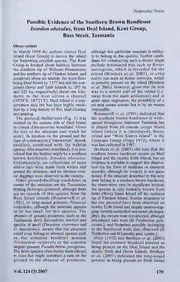
Possible Evidence of the Southern Brown Bandicoot 'Isoodon obesulus', from Deal Island, Kent Group, Bass Strait, Tasmania PDF
Preview Possible Evidence of the Southern Brown Bandicoot 'Isoodon obesulus', from Deal Island, Kent Group, Bass Strait, Tasmania
NaturalistNotes Possible Evidence ofthe Southern Brown Bandicoot Isoodon obesulus from Deal Island, Kent Group, , Bass Strait, Tasmania Observations In March 1999 the authors visited Deal although this particular structure is unlike- Island (Kent Group) to survey the island ly to belong to this species. Further candi- for burrowing crayfish species. The Kent dates for constructing such a shelter might Group is located about halfway between include introduced rats such as Rattus the southern tip of Wilsons Promontory norvegicus, which is recorded for the and the northern tip ofFlinders Island, and island (Brothers et al. 2001), or even comprises about six islands, themain three native rats such as Rattus lutreolus, which beingDeal Island(c. 1577ha) andthecon- is possibly present on the island (Brothers joined Dover and Erith islands (c. 295 ha et al. 2001). Flowever, given that the nest and 323 ha, respectively) about one kilo- was in a remote part of the island (i.e. metre to the west across a channel away from the main settlement) and in (39°28’S, 147°21’E). Deal Island is a con- quite open vegetation, the possibility ofa servation area but has been highly modi- rat nest seems remote but is by no means fied by a long history offire, land clearing impossible. andgrazing. Rounsevell et al. (1991) indicated that The pictured shelter/nest (Fig. 1) was the southern brown bandicoot is wide- located on the eastern side of Deal Island spread throughout mainland Tasmania but in closed Allocasuarina woodland. Given is absent from all islands except Maria the size of the structure (see watch for Island (where it is introduced), Bruny scale), its location on the ground and the Island and “West Sisters Island” in the type ofconstruction (“interwoven” sheoak Furneaux Group (Hope 1972), where it needles), combined with the habitat waslastcollectedin 1987. (grassyAllocasuarinawoodland), it ispos- Brothers et al. (2001) did note that the tulated that the buildermightbe a southern southern brown bandicoot occurs on Deal brown bandicoot, Isoodon obesulus. Island and the nearby Erith Island, but no Unfortunately, no collections of scats evidenceisavailabletosupportthisobserva- and/or hair were made from within and tion (in the form ofdatabase or museum around the structure, and no obvious coni- records), although its veracity is not ques- cal diggingswereobserved inthevicinity. tioned. Ifthe structuredescribed in this note Other ground-dwelling candidates as does belong to a southern brown bandicoot, owner ofthe structure are the Tasmanian the observation may be significant because bettongBettongiagaimardi althoughthere the species is only formally known from , are no records of this species from the Inner (West) Sister Island offthe northern Bass Strait islands (Rounsevell et al. tip ofFlinders Island. Similar structures to 1991), or long-nosed potoroo, Potorous the one pictured have been observed on tridactylus although the structure appears nearby ErithIsland and despitecamera-trap- , to be too small for this species. The ping (remote-controlled nocturnal photogra- absence ofground predators, such as the phy),theownerswerenotdetected,although Tasmanian devil Sarcophilus harrisii and introduced rats were (D Pemberton pers. species ofquoll (Dasyurus viverrinus and comm.), and footprints possibly belonging D. maculatus), means that the structure to the bandicoot were also observed (D could even belong to arboreal species such PembertonandB Lazenbypers.comm.). as the common brushtail possum Hope (1972) and Brothers et al. (2001) Trichosurus vulpecula or the common listed the common brushtail possum as ringtail possum Pseudocheirusperegrinus. being present on the Deal Island and the The latterspeciesoften buildsnests(dreys) nearby Erith and Dover Islands. Brothers in trees but might construct a nest on the et al. (2001) indicated the long-nosed ground in the absence of predators. potoroo as being present on Erith Island Vol. 124 (3) 2007 179 NaturalistNotes and Hope (1972) reported subfossil collec- Acknowledgements tions ofthe potoroo from Deal Island from Thanks to Phil Bell, Sally Bryant, Mike agullyaboveWinterCove. MDroioensseeyn,, SRaorsaehmaMruynkGasl,esD,aGvriedgPHeomcbkeirntgo,nNaincdk In conclusion, in the absence of other Hans and Annie Wapstra for their thoughts on evidence such as scats or hairs, it is not the owner ofthe structure. David Pemberton possible to confirm the identity of the commented on an earlier draft ofthis note, and owner of this structure. However, the comments ofan anonymous reviewer clarified information is presented to allow discus- sKeivnegralfoproitnhtesi.r aTshsainsktsancteo dRuorbinKginthgeabnudrrSoewriennga sion ofits possible significance, especially crayfish surveys, and in particular the inex- iffurtherevidence comes to light ofsouth- haustiblescrub-bashingeffortsofRob. ern brown bandicoots, common ringtail possums orlong-nosed potoroos being pre- References sent on Deal Island itself or on nearby Br(o2t0h0e1r)sTNa,smPaenmiba’esrtOofnfsDh,orePrIysolrandHs:anSedabHiarldlseyanVd Erith and Dover Islands. Further surveys other NaturalFeatures. (Tasmanian Museum and for mammals on the Kent Group using a ArtGallery,Hobart) variety oftechniques (e.g. hair-tubes, cam- HoPpreocJeeHdi(n1g9s72o)fMthaemRmoavlalsSoofcitehteyBoafsVsicSttorraiiat8i5sl.a1n6d3s-. era-traps, small and large cage traps, spot- 195. lighting, scats and tracks survey) appears RoDuinssterivbeultlionDEr,ecoTradysloorfnRaJtiavendterHroesctkriianlgmaGmJm(a1l9s91i)n tobewarranted. TrTiagsgmsanBia(.19W9i6ld)liTfreaRcekss.eaSrccahts18a,n69d9-O7t1h7e.r Traces: a ECOtas,M28aSrunkcrWesatpAsvtenruae FUniievledrsGituyiPdreesst,oMAeulsbtoruarlniea)n Mammals. (Oxford LenahValley,Tasmania7008 Email:[email protected] and Niall Doran ResourceManagementandConservation DepartmentofPrimaryIndustriesandWater GPOBox44,Hobart.Tasmania7001 eFixgt.en1d.sSftorrucatbuoruetm2a0-d3e0pcrmedboamciknainnttloythoefismhaegoea.kTnheeedrlaeiss.edTShheeoenatkranneceedliessca.t1t0hectmopdcieanmterteeorfatnhde image are where they rest against a small diameter Sheoak stem. The watch provides a scale. It is notedthatthestructure isremarkablysimilartothenestofaLong-nosed BandicootPeramelesnasu- tapictureonpage216ofTriggs(1996). The Victorian Naturalist 180
